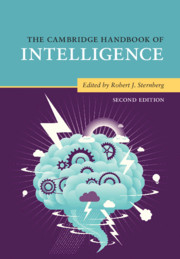Book contents
- The Cambridge Handbook of Intelligence
- The Cambridge Handbook of Intelligence
- Copyright page
- Dedication
- Contents
- Figures
- Tables
- Contributors
- Preface
- Part I Intelligence and Its Measurement
- Part II Development of Intelligence
- 6 Genetic Bases of Intelligence
- 7 Intelligence in Infancy
- 8 Intelligence in Childhood
- 9 Intelligence in Adulthood
- 10 Developing Intelligence through Instruction
- Part III Intelligence and Group Differences
- Part IV Biology of Intelligence
- Part V Intelligence and Information Processing
- Part VI Kinds of Intelligence
- Part VII Intelligence and Its Role in Society
- Part VIII Intelligence and Allied Constructs
- Part IX Folk Conceptions of Intelligence
- Part X Conclusion
- Author Index
- Subject Index
- References
8 - Intelligence in Childhood
from Part II - Development of Intelligence
Published online by Cambridge University Press: 13 December 2019
- The Cambridge Handbook of Intelligence
- The Cambridge Handbook of Intelligence
- Copyright page
- Dedication
- Contents
- Figures
- Tables
- Contributors
- Preface
- Part I Intelligence and Its Measurement
- Part II Development of Intelligence
- 6 Genetic Bases of Intelligence
- 7 Intelligence in Infancy
- 8 Intelligence in Childhood
- 9 Intelligence in Adulthood
- 10 Developing Intelligence through Instruction
- Part III Intelligence and Group Differences
- Part IV Biology of Intelligence
- Part V Intelligence and Information Processing
- Part VI Kinds of Intelligence
- Part VII Intelligence and Its Role in Society
- Part VIII Intelligence and Allied Constructs
- Part IX Folk Conceptions of Intelligence
- Part X Conclusion
- Author Index
- Subject Index
- References
Summary
Children provide a unique and valuable window onto understanding human intelligence. A key feature of childhood is the capacity to take in, organize, and process information in a manner that gives rise to a variety of intelligent behaviors and modes of reasoning. Although children lack content knowledge and experience, they are experts at learning – and sometimes demonstrate even better learning potential than adults. This learning is situated in the social world, which allows children to selectively learn from other people and engage in the process of cultural transmission. The study of children also deeply considers the reasons for children’s errors and the mechanisms underlying the development of more intelligent thought. The chapter is organized into five sections, each addressing a key theme of childhood intelligence: continuity amid developmental change, multiple modes of reasoning, when children outperform adults, the role of social context, and policy implications. Each section focuses on a few content areas that illustrate the theme and how it relates to intelligence. We draw on literature from the full childhood period from two years to eighteen years, though the primary focus is on children in preschool and elementary school (2–10), where the majority of research has been done.
- Type
- Chapter
- Information
- The Cambridge Handbook of Intelligence , pp. 155 - 180Publisher: Cambridge University PressPrint publication year: 2020
References
- 2
- Cited by

